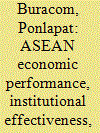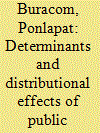|
|
|
Sort Order |
|
|
|
Items / Page
|
|
|
|
|
|
|
| Srl | Item |
| 1 |
ID:
134440


|
|
|
|
|
| Summary/Abstract |
Foreign direct investment (FDI) is considered to be one of the most important forces of economic growth and globalization. Many ASEAN economies have only a small domestic market; they are heavily reliant on international trade and FDI. Recent studies on cross-border investment indicate the importance of domestic economic performance and institutional effectiveness (including government effectiveness, regulatory quality, rule of law and property rights protection) in attracting FDI. The result from a cross-national empirical analysis, in this study, also confirms the significant impact of macroeconomic performance and institutional factors on FDI flows into developing countries. In this paper, it is argued that, with the exception of Singapore, most ASEAN countries are afflicted with relatively poor institutions for good governance, with low government effectiveness, and poor regulatory quality and rule of law. This relatively poor institutional quality may exacerbate the effects of external threats. As higher economic growth and better economic integration in other regions may divert FDI flows into ASEAN countries, their appropriate response is to improve institutional quality so that the share of FDI will increase in the total FDI inflows. Improving the institutional environment among ASEAN member countries should, therefore, be an important goal of ASEAN economic integration.
|
|
|
|
|
|
|
|
|
|
|
|
|
|
|
|
| 2 |
ID:
107982


|
|
|
|
|
| Publication |
2011.
|
| Summary/Abstract |
Social spending in Thailand is allocated in response to several demand and supply factors. Globalization and inequality tend to compel the governments, both elected and nonelected, to increase generous education, health, and welfare programs for social sectors that fall behind. An increase in revenue from direct taxes and the previous year's spending level has also had a positive effect on the current rate of public spending on education, health, and welfare in Thailand. Overall public spending on education, health, and welfare is not very well targeted, despite the increase in the shares of education, health, and welfare spending and the recent introduction of new social programs in Thailand. These increases had the stated objective of increasing access of the poor to education, health, and welfare services, including an expansion of basic education from nine to twelve years, a student loan program, a universal health-insurance scheme, and the expansion of other welfare services. Public spending on basic education is primarily propoor, but the disparities in access to education continue to exist at all levels of education. Although the resulting benefit incidence of public spending on health services in 2007 was less prorich compared with the past, the majority of public health spending still favors higher income classes. The social security scheme coverage is also limited to a small section of the Thai labor force. These findings pose a challenge to policymakers, and the author therefore explores their policy implications.
|
|
|
|
|
|
|
|
|
|
|
|
|
|
|
|
|
|
|
|
|